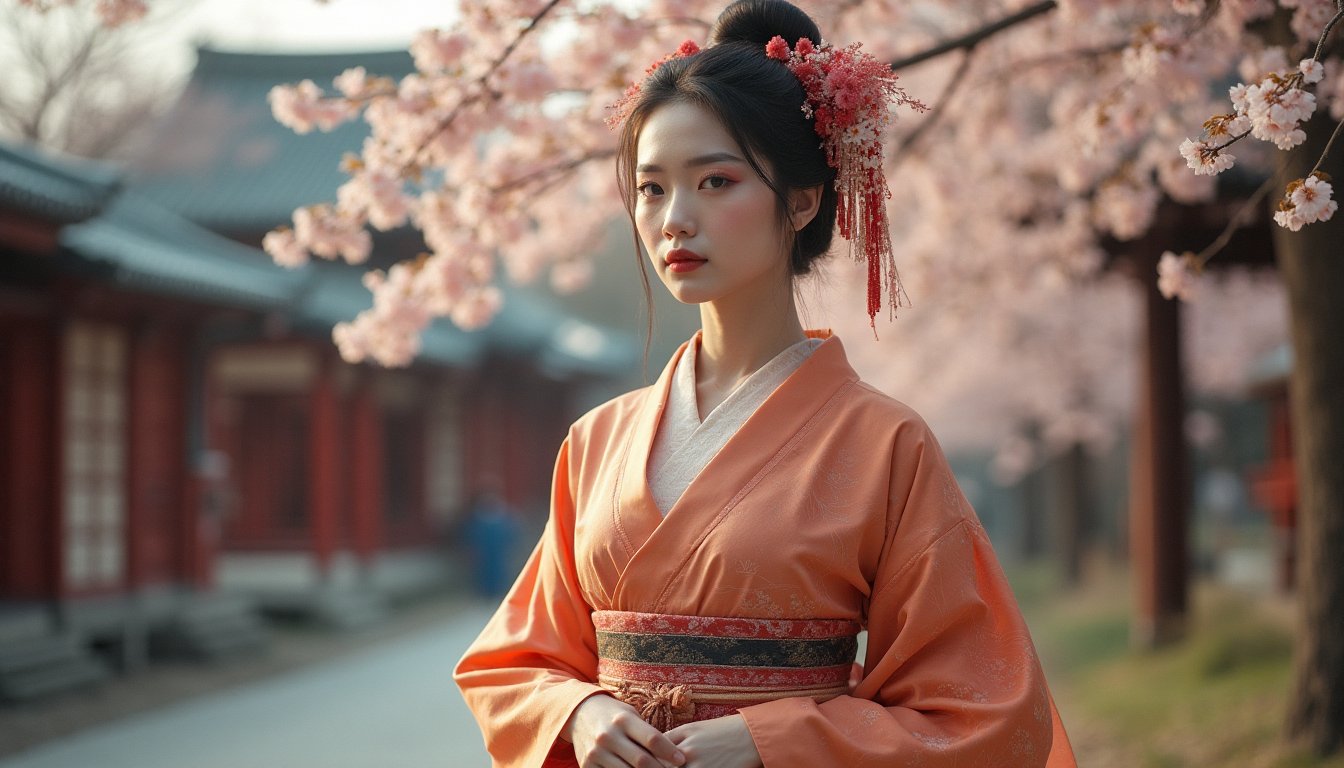Love Across Time and Tradition: The Dynamics of Relationships in Historical Contexts
Imagine a stunning Japanese woman from the Edo Period, elegantly standing in Nara Park, surrounded by cherry blossoms and ancient temples. Dressed in a beautifully tailored kimono, she embodies the balance of tradition and modern allure. This visual serves as a profound metaphor for the complexities of relationships, especially those that weave together different cultural backgrounds and societal expectations. In this article, we will dive deep into the dynamics of these unique partnerships, celebrating the harmony of love while addressing the challenges they face.
The Beauty of Blended Cultures
Couples who come from different cultural or historical backgrounds offer a rich tapestry of experiences, values, and traditions. Just like our Edo Period engineer, these individuals adapt their legacies to create something new. Relationships that merge diverse heritages often produce vibrant and exciting outcomes, both emotionally and socially.
For example, think about a modern-day cross-cultural couple: she’s a spirited young woman from a Japanese heritage, while he’s a brilliant artist from the West. Together, they not only share their love but also their customs, languages, and ways of life. This sharing doesn’t just enhance their partnership; it contributes to a broader understanding of their cultures, and challenges stereotypes.
Research shows that cultural exchange in relationships can foster empathy and stronger emotional connections. According to studies by the American Psychological Association, couples who actively engage in each other's cultures report higher levels of satisfaction and resilience in their relationships.
Love Languages: The Key to Connection
Understanding love languages is like having a secret decoder ring for your relationship. In a multicultural partnership, knowing each other's love languages can build bridges where there might otherwise be misunderstandings.
For instance, let’s break down the five love languages as outlined by Dr. Gary Chapman:
- Words of Affirmation: Verbal acknowledgment can be especially meaningful in cultures that emphasize respect and honor.
- Acts of Service: Cooking a traditional meal from one partner's culture can be a powerful act of love.
- Receiving Gifts: Gifts that reflect cultural significance often communicate deeper meanings than their commercial value.
- Quality Time: Spending time celebrating each other's festivals can deepen bonds.
- Physical Touch: For many cultures, physical closeness is an essential part of showing love.
Think about a couple where one partner values “Acts of Service”—say, a Japanese partner who finds joy in caring for others through cooking traditional dishes—while the other thrives on “Words of Affirmation.” If the Western partner is showering the Japanese partner with compliments without backing it up with action, it can create friction.
In romantic relationships, this misalignment can lead to feelings of neglect or unappreciation. To avoid the love language trap, couples are encouraged to have candid conversations about their preferences and expectations.
Challenges Along the Journey
Despite the enchantment of blended relationships, they come with their own set of challenges. Different cultural expectations can lead to misunderstandings or conflicts. Imagine the stunning engineer from our earlier imagery. Her passion for engineering might challenge the traditional roles expected of women in her society, leading to clashes not only within her community but potentially in her personal relationships as well.
Take, for example, a modern-day couple: a woman from a progressive background marrying into a family with strict traditional values. Here, the challenges arise in navigating a sea of family expectations and personal desires. This friction can lead to identity crises, emotional distance, or even family conflict, mirroring the struggles faced by our Edo Period engineer.
A poignant anecdote could be a couple, both talented individuals, where the man is encouraged to pursue his dreams while the woman feels constrained by her own familial obligations. This imbalance can create a sense of resentment or longing to escape—a romantic betrayal of unspoken dreams. Encouraging open discussions about these issues is crucial. Strategies might include:
- Regular check-ins to gauge emotional welfare.
- Attending family counseling to navigate cultural clashes.
- Empowering each other to pursue personal dreams without guilt.
Harnessing the Power of Empowerment
The empowerment of both partners is vital in any relationship, especially in cross-cultural scenarios. Just as our Edo engineer asserts herself in a male-dominated profession, both partners must support each other's ambitions. Here’s where the beauty of mutual empowerment comes into play.
When both partners feel valued, they can tackle life's challenges together. For instance, creating a shared vision board that includes individual and shared goals can help visualize mutual support. This concept reinforces accountability while creating a sense of unity rooted in respect and understanding.
Celebrating Progress and Growth
Growth in relationships is not a straight path. Just like the blooming cherry blossoms around our Edo engineer, love evolves with time. Each couple can celebrate their unique milestones, such as learning each other's languages, participating in cultural events, or even blending family traditions.
One couple we might profile could celebrate年度 (nenkame), a tradition in Japan where families reflect on their past year. By choosing to share their own yearly highlights and learnings, they can celebrate their unique journey together while embracing their diverse identities.
Moreover, research indicates that couples who participate in cultural rituals often feel more connected and engaged with each other. The most beautiful part? These celebrations of love create unforgettable memories that serve as stepping stones during rough patches.
Final Thoughts
Love is a journey, a complex dance between cultures, identities, and ambitions. The marriage of a Japanese engineer from the Edo Period and a modern partner showcases a narrative rich with possibilities. Couples can celebrate their differences while navigating the challenges together confidently.
Now, I invite you to reflect: What are some cultural traditions in your relationships that strengthen your bonds? How do you empower each other to grow?
Let us continue this conversation in the comments below, and if you want to explore more on relationship dynamics, don't forget to subscribe to our newsletter and become a permanent resident of iNthacity: the "Shining City on the Web"! Like, share, and engage, so we can all learn from each other's stories.
Disclaimer: This article may contain affiliate links. If you click on these links and make a purchase, we may receive a commission at no additional cost to you. Our recommendations and reviews are always independent and objective, aiming to provide you with the best information and resources.
Get Exclusive Stories, Photos, Art & Offers - Subscribe Today!
























Post Comment
You must be logged in to post a comment.